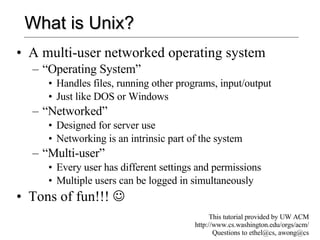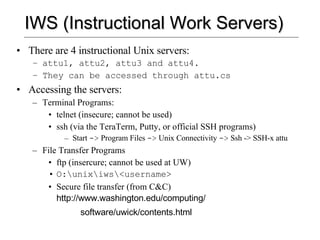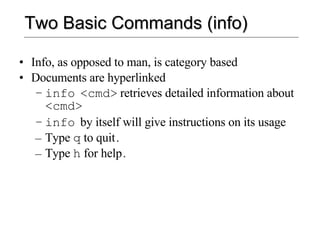Unix Basics 04sp
- 1. What is Unix? A multi-user networked operating system “Operating System” Handles files, running other programs, input/output Just like DOS or Windows “Networked” Designed for server use Networking is an intrinsic part of the system “Multi-user” Every user has different settings and permissions Multiple users can be logged in simultaneously Tons of fun!!! This tutorial provided by UW ACM http://www.cs.washington.edu/orgs/acm/ Questions to ethel@cs, awong@cs
- 2. IWS (Instructional Work Servers) There are 4 instructional Unix servers: attu1, attu2, attu3 and attu4. They can be accessed through attu.cs Accessing the servers: Terminal Programs: telnet (insecure; cannot be used) ssh (via the TeraTerm, Putty, or official SSH programs) Start -> Program Files -> Unix Connectivity -> Ssh -> SSH-x attu File Transfer Programs ftp (insercure; cannot be used at UW) O:\unix\iws\<username> Secure file transfer (from C&C) http://www.washington.edu/computing/ software/uwick/contents.html
- 3. Logging In Which server you use (almost) doesn’t matter – all four allows access to your files Although your Windows and Unix usernames (and passwords) are the same, they are two separate accounts Your z: drive is not your Unix account Connecting: We’ll connect to the Unix machines via ssh After connection, you are presented with a login prompt After logging in, you’re placed in your home directory (where your personal files are located)
- 4. The Command Prompt Commands are the way to “do things” in Unix A command consists of a command name and options called “flags” Commands are typed at the command prompt In Unix, everything (including commands) is case-sensitive [prompt]$ <command> <flags> <args> attu1:/u15/awong$ ls –l -a unix-tutorial Command Prompt Command (Optional) flags (Optional) arguments Note : In Unix, you’re expected to know what you’re doing. Many commands will print a message only if something went wrong.
- 5. Two Basic Commands The most useful commands you’ll ever learn: man (short for “ man ual”) info They help you find information about other commands man <cmd> or info <cmd> retrieves detailed information about <cmd> man –k <keyword> searches the man page summaries (faster, and will probably give better results) man –K <keyword> searches the full text of the man pages fiji:/u15/awong$ man –k password passwd (5) - password file xlock (1) - Locks the local X display until a password is entered fiji:/u15/awong$ passwd
- 6. Two Basic Commands (info) Info, as opposed to man, is category based Documents are hyperlinked info <cmd> retrieves detailed information about <cmd> info by itself will give instructions on its usage Type q to quit . Type h for help .
- 7. Directories In Unix, files are grouped together in other files called directories , which are analogous to folders in Windows Directory paths are separated by a forward slash: / Example: /u10/hctang/classes/cse326 The hierarchical structure of directories (the directory tree) begins at a special directory called the root , or / Absolute paths start at / Example: /u10/hctang/classes/cse326 Relative paths start in the current directory Example: classes/cse326 (if you’re currently in /u10/hctang ) Your home directory is where your personal files are located, and where you start when you log in. Example: /u10/hctang
- 8. Directories (cont’d) Handy directories to know ~ Your home directory .. The parent directory . The current directory ls L i S ts the contents of the specified directories (or the current directory if no files are specified) Syntax: ls [<file> … ] Example: ls backups pwd P rint W orking D irectory
- 9. Directories (cont’d further) cd C hange D irectory (or your home directory if unspecified) Syntax: cd <directory> Examples: cd backups/unix-tutorial cd ../class-notes mkdir M a K e DIR ectory Syntax: mkdir <directories> Example: mkdir backups class-notes rmdir R e M ove DIR ectory, which must be empty Syntax: rmdir <directories> Example: rmdir backups class-notes
- 10. Files Unlike Windows, in Unix file types (e.g. “executable files, ” “data files,” “text files”) are not determined by file extension (e.g. “foo.exe”, “foo.dat”, “foo.txt”) Thus, the file-manipulation commands are few and simple … Many commands only use 2 letters rm R e M oves a file, without a possibility of “undelete!” Syntax: rm [options] <file(s)> Example: rm tutorial.txt backups/old.txt -r option: recursive (delete directories) -f option: force. Do no matter what
- 11. Files (cont’d) cp C o P ies a file, preserving the original Syntax: cp [options] <sources> <destination> Example: cp tutorial.txt tutorial.txt.bak -r option: recursive (copies directories) mv M o V es (renames) a file or directory, destroying the original Syntax: mv [options] <sources> <destination> Examples: mv tutorial.txt tutorial.txt.bak mv tutorial.txt tutorial-slides.ppt backups/ Note : Both of these commands will over-write existing files without warning you!
- 12. Permissions for files Files are owned by both a user and a group You will either belong to ugrad_cs or ugrad_ce Each file has 3 sets of permissions Permissions for the user who owns it (user permissions) Permissions for the group that owns it (group permissions) Permissions for everyone else (‘other’ or ‘world’ permissions) There are 3 types of permissions Read -- controls ability to read a file Write -- controls ability to write or change a file Executable -- controls whether or not a file can be executed as a program
- 13. Permissions for files (example) To see the permissions on a file, do a ‘ ls –l ’ attu4:/u15/awong$ ls –l -r--r--r-- 1 awong ugrad_ce 17375 Apr 26 2000 rgb.txt -rw-r--r-- 1 awong ugrad_ce 17375 Apr 5 02:57 set10.csv drwxr-xr-- 1 awong ugrad_ce 1024 Jan 19 19:39 tests Changing Permissions chmod [ugo]+[rxw] <filename> e.g. chmod u+w rgb.txt gives me permission to change rgb.txt Changing Ownership chown <user>.<group> <filename> e.g. chmod awong.iuns rgb.txt iuns group now owns rgb.txt Note: You cannot change which user owns file, unless you are an administrator, for security reasons.
- 14. Permissions on directories Directories can also be thought of as a file that lists all the files it contains. They also belong to a user and a group They have the same 3 sets of permissions For directories, this is what the permissions mean Read -- You can read the list of files (eg. You can use “ls” and get the directory contents) Write -- You can change the list of files (eg. You can add or remove files from the directory) Executable -- You can use the directory list to let the operating system “find” the file. This means, you have access to the file. All directories generally have execute permission.
- 15. Permissions Quiz Given the following output for ‘ ls –la ~ ’ for user awong.ugrad_ce attu4:/u15/awong$ ls –la ~ drwxr----x 1 awong ugrad_ce 1024 Jan 19 19:39 . drwxr-xr-x 1 root root 17375 Apr 26 2000 .. -rw-r--r-- 1 awong ugrad_ce 17375 Apr 5 02:57 readme.txt -rw-rwxr-x 1 awong ugrad_ce 17375 Apr 5 02:57 myprog For users ethel.ugrad_ce, jjlin@ugrad_cs, and awong.ugrad_ce: Who can create files in this directory? Who can get the list of files in this directory? Who can read the contents of the files readme.txt? How about myprog? Who can run the program “myprog”? What is dangerous about the permissions on myprog? Especially the ‘.’ directory had g+w access? Can you think of a reason why you would give someone execute, but not read permissions on a directory? How read but not execute?
- 16. Shell Shortcuts Tab completion Type part of a file/directory name, hit <tab> , and the shell will finish as much of the name as it can Works if you’re running tcsh or bash Command history Don’t re-type previous commands – use the up-arrow to access them Wildcards Special character(s) which can be expanded to match other file/directory names * Zero or more characters ? Zero or one character Examples: ls *.txt rm may-?-notes.txt
- 17. Editing Text Which text editor is “the best” is a holy war. Pick one and get comfortable with it. Three text editors you should be aware of: pico – Comes with pine ( Dante ’s email program) To quit: Ctrl-q emacs/xemacs – A heavily-featured editor commonly used in programming To quit: Ctrl-x Ctrl-c vim/vi – Another editor, also used in programming To quit: <Esc> : q <Enter> (or QQ -- capitals matter) Knowing the basics of emacs and vim will help with the rest of Unix; many programs have similar key sequences.
- 18. Printing READ THE MORE UPDATED PRINTING TUTORIAL: http://www.cs.washington.edu/orgs/acm/tutorials/printing Printing: lpr : print Use –h (no header) and –Zduplex (double-sided) to save paper lpq : check the print queue (including Windows print jobs!) lprm : remove print jobs (including Windows print jobs) For the above commands, you will need to specify the printer with the option: –P<printer name> Check out enscript (quizlet: how do you find information about commands?) to print text files nicely! WARNING: Do NOT use enscript with postscript files!
- 19. Programs and Compilation (C++) To compile a program: g++ <options> <source files> Recommended: g++ -Wall –ansi –o <executable_name> *.cpp -Wall – W arnings: ALL -ansi – Strict ANSI compliance Quizlet: what does *.cpp mean? What’s an “executable”? In Windows, double-clicking on an icon runs a program E.g. double-click on C:\Windows\notepad.exe In Unix, you can run your executable from the command line! Type the executable name at the prompt, just like a command In fact, commands are actually executables However, you may need to specify the path to your executables ./<program> runs <program> in the current directory Example: attu4:ehsu% g++ -Wall –ansi –o hello hello.cpp attu4:ehsu% ./ hello
- 20. Programs and Compilation (Java) To compile a program: javac fileName1.java filename2.java . . . Errors will be printed to the screen with their line numbers Remember that the class name must have the same capitalization as the file name To compile all the .java files in the current folder: javac *.java To run : java classname (remember, no .java or .class) This will run the main method for that class.
- 21. X-Windows X-Windows is the most common graphical interface for Unix It allows graphics to be sent over the network (Windows Remote Desktop is similar to this) If you login via the ssh-x shortcuts, you will start and “X-server” on your machine and you will be able to get graphics from your unix commands If you log into a linux box, you will automatically have X-windows setup in that login.
- 22. Linux Machines, iuns Linux Machines: There are 6 linux machines in each lab The graphics work smoother on those machines Be sure to get a good “Window Manager” setup Ask one of the other people using the linux boxes for help setting up your window manager. Iuns: Iuns is the “instruction unsupported” software group Student volunteers maintain cutting edge software for unix and windows E-mail [email_address] for more info



![The Command Prompt Commands are the way to “do things” in Unix A command consists of a command name and options called “flags” Commands are typed at the command prompt In Unix, everything (including commands) is case-sensitive [prompt]$ <command> <flags> <args> attu1:/u15/awong$ ls –l -a unix-tutorial Command Prompt Command (Optional) flags (Optional) arguments Note : In Unix, you’re expected to know what you’re doing. Many commands will print a message only if something went wrong.](https://image.slidesharecdn.com/unixbasics04sp-1216393546096238-8/85/Unix-Basics-04sp-4-320.jpg)



![Directories (cont’d) Handy directories to know ~ Your home directory .. The parent directory . The current directory ls L i S ts the contents of the specified directories (or the current directory if no files are specified) Syntax: ls [<file> … ] Example: ls backups pwd P rint W orking D irectory](https://image.slidesharecdn.com/unixbasics04sp-1216393546096238-8/85/Unix-Basics-04sp-8-320.jpg)

![Files Unlike Windows, in Unix file types (e.g. “executable files, ” “data files,” “text files”) are not determined by file extension (e.g. “foo.exe”, “foo.dat”, “foo.txt”) Thus, the file-manipulation commands are few and simple … Many commands only use 2 letters rm R e M oves a file, without a possibility of “undelete!” Syntax: rm [options] <file(s)> Example: rm tutorial.txt backups/old.txt -r option: recursive (delete directories) -f option: force. Do no matter what](https://image.slidesharecdn.com/unixbasics04sp-1216393546096238-8/85/Unix-Basics-04sp-10-320.jpg)
![Files (cont’d) cp C o P ies a file, preserving the original Syntax: cp [options] <sources> <destination> Example: cp tutorial.txt tutorial.txt.bak -r option: recursive (copies directories) mv M o V es (renames) a file or directory, destroying the original Syntax: mv [options] <sources> <destination> Examples: mv tutorial.txt tutorial.txt.bak mv tutorial.txt tutorial-slides.ppt backups/ Note : Both of these commands will over-write existing files without warning you!](https://image.slidesharecdn.com/unixbasics04sp-1216393546096238-8/85/Unix-Basics-04sp-11-320.jpg)

![Permissions for files (example) To see the permissions on a file, do a ‘ ls –l ’ attu4:/u15/awong$ ls –l -r--r--r-- 1 awong ugrad_ce 17375 Apr 26 2000 rgb.txt -rw-r--r-- 1 awong ugrad_ce 17375 Apr 5 02:57 set10.csv drwxr-xr-- 1 awong ugrad_ce 1024 Jan 19 19:39 tests Changing Permissions chmod [ugo]+[rxw] <filename> e.g. chmod u+w rgb.txt gives me permission to change rgb.txt Changing Ownership chown <user>.<group> <filename> e.g. chmod awong.iuns rgb.txt iuns group now owns rgb.txt Note: You cannot change which user owns file, unless you are an administrator, for security reasons.](https://image.slidesharecdn.com/unixbasics04sp-1216393546096238-8/85/Unix-Basics-04sp-13-320.jpg)








![Linux Machines, iuns Linux Machines: There are 6 linux machines in each lab The graphics work smoother on those machines Be sure to get a good “Window Manager” setup Ask one of the other people using the linux boxes for help setting up your window manager. Iuns: Iuns is the “instruction unsupported” software group Student volunteers maintain cutting edge software for unix and windows E-mail [email_address] for more info](https://image.slidesharecdn.com/unixbasics04sp-1216393546096238-8/85/Unix-Basics-04sp-22-320.jpg)